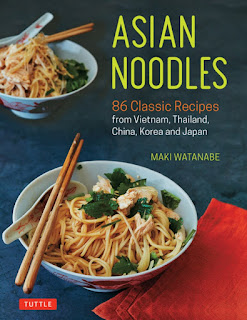30 October 2019
28 October 2019
Stacked-Up Book Thoughts: 5 Short Book Reviews
 I'm
going to start this post with the obligatory question/exclamation: How
can we be just days away from November? I haven't yet cleaned off my
deck, I never did finish weeding the garden . . . Sigh.
I'm
going to start this post with the obligatory question/exclamation: How
can we be just days away from November? I haven't yet cleaned off my
deck, I never did finish weeding the garden . . . Sigh.
I
don't have a lot of chitchat this week because I'm still catching up
from being away. My hope is that by Friday, life will have settled back
down, just in time for me to get ready for my annual fall lace-making
getaway. You'll hear more about that later.
This week's
reviews are extra short because that's all the energy I have. Here's
what I read and listened to over the last couple of weeks.
 Virga & Bone: Essays from Dry Places by Craig Childs
(Torrey House Press, Oct. 1): If you like essays about nature and our
connections to it, you'll like this slim volume of a half dozen essays
of observations about various places in the American Southwest. Childs
writes about all kinds of desert things: temperature variations in Death
Valley, the juxtaposition of bleached bones (the end of life) with the
occasional rain (the beginning of life), and the layers of seashells
found on the dry side of the Colorado Rockies. He talks about the people
he meets and his observations on animals and insects. He also discusses
the way people have changed the desert, from ancient indigenous
populations all the way to the atomic bomb tests and on to
twenty-first-century hunters and scientists. Childs gives you a lot to
think about. (digital copy provided by the publisher)
Virga & Bone: Essays from Dry Places by Craig Childs
(Torrey House Press, Oct. 1): If you like essays about nature and our
connections to it, you'll like this slim volume of a half dozen essays
of observations about various places in the American Southwest. Childs
writes about all kinds of desert things: temperature variations in Death
Valley, the juxtaposition of bleached bones (the end of life) with the
occasional rain (the beginning of life), and the layers of seashells
found on the dry side of the Colorado Rockies. He talks about the people
he meets and his observations on animals and insects. He also discusses
the way people have changed the desert, from ancient indigenous
populations all the way to the atomic bomb tests and on to
twenty-first-century hunters and scientists. Childs gives you a lot to
think about. (digital copy provided by the publisher)
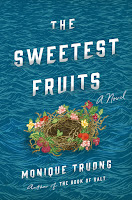 The Sweetest Fruits by Monique Truong
(Viking, Sept. 3): This is a fictionalized account of the life of the
journalist, author, and teacher Lafcadio Hearn (also known as Koizumi
Yakumo), as told through the eyes of the four significant women in his
life. I have very mixed feelings about this book, primarily because I
didn't realize until I finished it that the novel was based on a real
person. Thus I was kind of in the dark and didn't connect at all to the
story or to Hearn's extensive travels and relationships. Truong's
writing was fine, but without the context, I felt lost. I listened to
the unabridged audiobook (Penguin Audio; 9 hr, 25 min), read by
Cassandra Campbell, Lisa Flanagan, Adenrele Ojo, and Emily Woo Zeller,
for a freelance assignment. I enjoyed all four performances. Note that
the book has won wide critical acclaim, presumably by people who knew
who Hearn was. (audio copy provided for a freelance assignment)
The Sweetest Fruits by Monique Truong
(Viking, Sept. 3): This is a fictionalized account of the life of the
journalist, author, and teacher Lafcadio Hearn (also known as Koizumi
Yakumo), as told through the eyes of the four significant women in his
life. I have very mixed feelings about this book, primarily because I
didn't realize until I finished it that the novel was based on a real
person. Thus I was kind of in the dark and didn't connect at all to the
story or to Hearn's extensive travels and relationships. Truong's
writing was fine, but without the context, I felt lost. I listened to
the unabridged audiobook (Penguin Audio; 9 hr, 25 min), read by
Cassandra Campbell, Lisa Flanagan, Adenrele Ojo, and Emily Woo Zeller,
for a freelance assignment. I enjoyed all four performances. Note that
the book has won wide critical acclaim, presumably by people who knew
who Hearn was. (audio copy provided for a freelance assignment)
 Royal Flush by Rhys Bowen
(Audible Studios; 2010; 8 hr, 31 min), narrated by Katherine Kellgren.
After that last book I needed something light and fun so I turned to the
third installment in the Royal Spyness cozy mystery series, which takes
place in England in the 1930s. Our hero is Lady Georgiana, who is 34th
in line to the throne and a cousin to the royal family. As with all good
cozies, Georgie never seems to be too far away from a murder or two. In
this outing, it appears that someone is targeting the royal family, and
Scotland Yard hopes Georgie will help them find the bad guy. Meanwhile,
in Scotland, Georgie's brother and sister-in-law find themselves with
unexpected American house guests, including that Simpson woman who has
caught the eye of Edward, the king to be. Lots of madness and mayhem,
good humor, great characters, a touch of romance, and a fun look at the
royal family. Kellgren does a marvelous job with the various accents and
characterizations. (personal collection)
Royal Flush by Rhys Bowen
(Audible Studios; 2010; 8 hr, 31 min), narrated by Katherine Kellgren.
After that last book I needed something light and fun so I turned to the
third installment in the Royal Spyness cozy mystery series, which takes
place in England in the 1930s. Our hero is Lady Georgiana, who is 34th
in line to the throne and a cousin to the royal family. As with all good
cozies, Georgie never seems to be too far away from a murder or two. In
this outing, it appears that someone is targeting the royal family, and
Scotland Yard hopes Georgie will help them find the bad guy. Meanwhile,
in Scotland, Georgie's brother and sister-in-law find themselves with
unexpected American house guests, including that Simpson woman who has
caught the eye of Edward, the king to be. Lots of madness and mayhem,
good humor, great characters, a touch of romance, and a fun look at the
royal family. Kellgren does a marvelous job with the various accents and
characterizations. (personal collection)
 What I Lick before Your Face: And Other Haikus by Dogs by Jamie Coleman
(Atria, Oct. 8): Attention all dog lovers: Here's the perfect stocking
stuffer, hostess/host gift, conversation starter, and feel-good book for
you. Coleman presents life from a dog's perspective as told through
haiku. I loved pretty much every single one of Coleman's poems. I was
laughing and smiling my through this delightful collection. The poems
cover such things as taking walks, curling up on the furniture, begging
for food, drinking out of the toilet, and fetching slippers.
What I Lick before Your Face: And Other Haikus by Dogs by Jamie Coleman
(Atria, Oct. 8): Attention all dog lovers: Here's the perfect stocking
stuffer, hostess/host gift, conversation starter, and feel-good book for
you. Coleman presents life from a dog's perspective as told through
haiku. I loved pretty much every single one of Coleman's poems. I was
laughing and smiling my through this delightful collection. The poems
cover such things as taking walks, curling up on the furniture, begging
for food, drinking out of the toilet, and fetching slippers.
Your ThingsEach poem is accompanied by a photograph of a dog that perfectly complements the sentiment. This book is so much fun to look through and read. You'll be tempted to recite all the haiku out loud to your family and friends. Put this on your gift list! (digital copy provided by the publisher)
You keep throwing it
I keep on bringing it back
Look. After. Your. Things.
 In Oceans Deep: Courage, Innovation, and Adventure beneath the Waves by Bill Streever
(Little, Brown, July 2): Streever, a lifelong diver, examines the
history, science, and technology of humankind's journey to explore the
depths of the ocean. Streever takes a personal approach to this book,
telling the story of underwater exploration by introducing us to the
people involved. We learn about the various types of submersibles, the
discovery of what causes the bends and how to prevent them, the effects
of being under pressure, and the different kinds of diving (with and
without tanks). I never thought about why space exploration seemed to
capture the attention of the government and of people's imaginations
more than the exploration of the ocean bottom--even with Jacques
Cousteau and the later discovery of The Titanic. Streever has
thoughts about this. He not only looks at history but also discusses the
future, such as the development of underwater robots. Humans are drawn
to the ocean depths for a lot of reasons beyond recreation, and Streever
explores many questions, including these: Could we someday have
underwater colonies? How can we make it safer for underwater work (for
example for building bridges)? What are the consequences of underwater
drilling? What's the status of underwater robots or drones? All in all
this is an interesting and entertaining book. I listened to the
unabridged audiobook (Hachette Audio; 9 hr, 3 min) read by Jay Snyder,
who is quickly becoming one of my go-to narrators for nonfiction. He
totally blurs that line between performer and author, drawing me solidly
into the book. (audio copy provided by the publisher)
Click for more
In Oceans Deep: Courage, Innovation, and Adventure beneath the Waves by Bill Streever
(Little, Brown, July 2): Streever, a lifelong diver, examines the
history, science, and technology of humankind's journey to explore the
depths of the ocean. Streever takes a personal approach to this book,
telling the story of underwater exploration by introducing us to the
people involved. We learn about the various types of submersibles, the
discovery of what causes the bends and how to prevent them, the effects
of being under pressure, and the different kinds of diving (with and
without tanks). I never thought about why space exploration seemed to
capture the attention of the government and of people's imaginations
more than the exploration of the ocean bottom--even with Jacques
Cousteau and the later discovery of The Titanic. Streever has
thoughts about this. He not only looks at history but also discusses the
future, such as the development of underwater robots. Humans are drawn
to the ocean depths for a lot of reasons beyond recreation, and Streever
explores many questions, including these: Could we someday have
underwater colonies? How can we make it safer for underwater work (for
example for building bridges)? What are the consequences of underwater
drilling? What's the status of underwater robots or drones? All in all
this is an interesting and entertaining book. I listened to the
unabridged audiobook (Hachette Audio; 9 hr, 3 min) read by Jay Snyder,
who is quickly becoming one of my go-to narrators for nonfiction. He
totally blurs that line between performer and author, drawing me solidly
into the book. (audio copy provided by the publisher)
Click for more
26 October 2019
Weekend Cooking: Home Made in the Oven by Yvette Van Boven
 You might remember that one of my favorite cookbooks from last year was Home Made Christmas by Yvette Van Boven. Well, one of my favorite cookbooks from this year is her Home Made in the Oven (Abrams, Oct. 15), which I received as part of the Abrams Dinner Party Program.
You might remember that one of my favorite cookbooks from last year was Home Made Christmas by Yvette Van Boven. Well, one of my favorite cookbooks from this year is her Home Made in the Oven (Abrams, Oct. 15), which I received as part of the Abrams Dinner Party Program.
Home Made in the Oven was one of the cookbooks I took to Maine, and I ended up making two things from this book before we lost power (see posts from this week for more on that). I have bunches more recipes to try, and I will be sure to share photos of the finished dishes over on Instagram.
I love the layout of Van Boven's new book, which contains but three recipe chapters: vegetables, fish and meat, and baking. Of course, you'll also find an introduction, in which Van Boven provides tips about using and oven and buying the ingredients.
Before I even got to the recipes, I fell in love with the matte pages and photographs of the finished dishes. Each recipe is accompanied by cute drawings, some of which outline the recipe directions and others are more whimsical (see the cover and the scan). I also noticed that each recipe is presented with a month label, which indicates the best time of year to make that dish: sometimes because of seasonal ingredients and other times because we usually like something lighter in the summer and heartier in the winter.
 Don't miss the recipe blurbs (aka introductions), because they contain personal stories, good information about the ingredients called for, and/or some history. For example, the introduction to the recipe I'm sharing today talks about quinoa: what it tastes like, whether it's ethically okay to eat it, and its nutritional value.
Don't miss the recipe blurbs (aka introductions), because they contain personal stories, good information about the ingredients called for, and/or some history. For example, the introduction to the recipe I'm sharing today talks about quinoa: what it tastes like, whether it's ethically okay to eat it, and its nutritional value.
As I expect from Van Boven, the recipes in Home Made in the Oven are flavorful, easy to make, use basic ingredients, and will quickly become family favorites. Some of the vegetable recipes I have marked to try are Roasted Beet Salad with Fresh Spring Herbs (for April), Mushroom Flammkuchen (a kind of pizza for November), and Twice-Baked Sweet Potatoes (for October).
Meat recipes include Comforting Meatballs (I made these and we loved them, for January), Chicken Gyro Wraps (for July, but I'm not waiting), and Salmon, Fennel, & Lemon with Spinach Miso-Mayo (for February). I love cookbooks that rely on fruit desserts, and Home Made in the Oven doesn't disappoint. I'm trying to decide between three different apple cakes, but the Clementine Yogurt Cake and Ginger-Orange Pantry-Clearing Cake also look really good.
The subtitle to Yvette Van Boven's Home Made in the Oven is "Truly Easy, Comforting Recipes for Baking, Broiling, and Roasting." I can fully attest to the easy and comforting, and I'd like to add "yummy." Vegetarians will find plenty of dishes to satisfy them, and the recipes are in fact easy enough for almost every home cook. I fully recommend Home Made in the Oven--you might want to add this to your holiday gift list. Here's a spread from the book: both dishes are vegetarian and both are on my try list (click image to enlarge):
I made the following broccoli dish and served it with a simple pan-sauteed meat, but this is hearty enough to be the main course. The leftovers heated up beautifully in the microwave, and we had it for a nice warming lunch. The house we were staying in didn't have the right baking dish, but the recipe came out perfectly. The only change I made was to use cashews instead of walnuts, only because that's what we had on hand up in Maine.
Quinoa & Broccoli from the Oven
Serves 4
3/4 cup plus 2 tablespoons (150 g) quinoa (any color)
- Scant 2 cups (450 ml) vegetable stock or water (I used chicken stock)
- 1 pound 7 ounces (650 g) broccoli florets (2 heads)
- 4 tablespoons (60 ml) olive oil, plus extra for greasing the baking dish
- Sea salt and freshly ground black pepper
- Pinch of red pepper flakes
- 1 garlic clove, pressed
- 1 1/2 cups (150 g) shredded cheese, such as Cheddar or Gouda (I used white Cheddar)
- About 1 cup plus 1 tablespoon (250 ml) vegetable stock or milk (I used chicken stock)
- Handful of shelled walnuts (I used pecans)
Cook the quinoa for 20 minutes in the scant 2 cups of stock until all the liquid has been absorbed. Remove from the heat and let evaporate for 10 minutes.
Combine the broccoli with the 2 tablespoons of oil, and salt and pepper to taste, arrange on a baking sheet lined with parchment paper. Roast for 20 minutes.
Toast the nuts in a dry skillet until crunchy; break into pieces.
Lower the oven temperature to 350F (180C). Mix the cooked quinoa with salt, pepper, red pepper flakes, garlic, two-thirds of the cheese, and the remaining stock until thoroughly combined.
Fold in the broccoli until they're entirely coated. Scoop this into a greased baking dish [I suggest 9 by 13 inch] and sprinkle with the remaining cheese and the nuts. Bake the dish for 25 minutes.
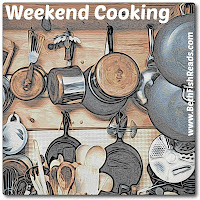 Weekend Cooking is open to anyone who has any kind of food-related post to share: Book reviews (novel, nonfiction), cookbook reviews, movie reviews, recipes, random thoughts, gadgets, quotations, photographs, restaurant reviews, travel information, or fun food facts. If your post is even vaguely foodie, feel free to grab the button and link up anytime over the weekend. You do not have to post on the weekend. Please link to your specific post, not your blog's home page.
Weekend Cooking is open to anyone who has any kind of food-related post to share: Book reviews (novel, nonfiction), cookbook reviews, movie reviews, recipes, random thoughts, gadgets, quotations, photographs, restaurant reviews, travel information, or fun food facts. If your post is even vaguely foodie, feel free to grab the button and link up anytime over the weekend. You do not have to post on the weekend. Please link to your specific post, not your blog's home page.NOTE: Mr. Linky sometimes is mean and will give you an error message. He's usually wrong and your link went through just fine the first time. Grrrr.
_______
Click for more
25 October 2019
Off the Shelf; Or What's New in My Corner of the World 5
 1. Maine 25; the BRFs 1
1. Maine 25; the BRFs 1
October
2019 did not go as planned. I was dreaming of regular workdays,
weekends off, and a 2-week working vacation in Maine. What did I get?
Way more work that I had planned for (not that I'm really complaining), 5
blissful days working out of pretty second-floor office on an island
off the coast of Maine, and a few nights of cooking out of new cookbooks
in a rental house kitchen.
The night before I was
going to take a day off to visit my friends at AudioFile Magazine in
Portland and then go shopping in Freeport, the bomb cyclone came roaring
up the eastern coast. It hit us at about 2am and an hour later, with
the house shaking and the wind howling, we lost all power, and along
with it our heat and water.
I'm sure glad it was really
dark out, as we hunkered down to wait out the storm, because in the
morning we discovered almost a dozen downed trees, which brought down
the power lines and barely missed the house. Yikes! It was scary night.
For
reasons too complicated to get into here, we were stuck in Maine for
another 4 days before we could load the car and drive back home. It's
going to be a dreary slog catching up with work.
Needless
to say, I didn't get much reading done and this was the slowest
audiobook week I've had in decades. At least we were safe, if a bit cold
and stressed.
2. New Books on the Doorstep

I'm
not quite sure why I got two picture books, but one is about all the
different kinds of foods being prepared in a city apartment building.
I'm
so excited to get a new Peter May, I haven't had a chance to even open
the cover, so I don't know where it takes place or what it's about. I
also got some speculative fiction from Tor, a fantasy and science
fiction imprint I trust.
The new Therese Anne Fowler
takes place in current times (I think) and is about a marriage, a
community, and racial tensions. This is likely to zoom to the top of the
pile. The Nanny is a British thriller full of mystery and family
secrets. Finally, I always love the National Geographic encyclopedia
books for kids; this one is about North America's indigenous
populations.
3. Current Life-Changing Discovery

I've never had an issue
keeping a family wall calendar in the kitchen for appointments, travel,
and social events. I've never had an issue keeping a time book for my
business. My stumbling block was recording daily tasks and to-dos, habit
tracking, and collections -- the heart of the bullet journal.
Then
one day over the summer I was wandering around YouTube and came across a
bunch of planner videos and I spotted one with a set up that looked
perfect for me. It turned out to be the new edition of the Life Planner
from Erin Condrin. Although I am totally not into decoration or stickers
-- I really, really want a functional planner -- this planner called to
me.
I love that I don't have to hand write out all the
monthly and weekly setups (one of the down sides of the BuJo), that it
has places for my monthly collections, and that each day is divided up
exactly how I need it to be. In case you're familiar with the EC Life
Planner, I got the neutral vertical.

I use the
smaller dotted box for habit tracking, and other boxes to track my
invoicing and income. Then comes the monthly view, on which I re-create
the family calendar, so I don't have to keep running downstairs to see
what's going on.
The weekly view, though, is what caught
my eye: For each day, I have a section for editing projects, a section
for writing projects, a section for personal items, and a small section
to track miscellaneous things. I use the side bar for my meal planning.
It's perfect (if a little pricey). The most important thing is that I'm
using it, and I'm more productive.
If you want to check it out for yourself go to the Erin Condren website. If you use my referral code (or anyone else's), you get $10 off your first purchase. I think I get something too, but I don't know what.
24 October 2019
6 Brand New Cookbooks for Modern Cooks and Families
Oh how the gods laugh when you make grandiose plans. I planned to
cook and bake my way through heaps of cookbooks during our recent
working trip to Maine. The bomb cyclone, including 90-mph winds, downed
trees, and no power, turned my plans upside down. Ooops!
Still,
I want to write about another batch of awesome cookbooks that have
October 2019 birthdays. A couple of these are geared to those of you on
special diets (such as keto), one focuses on my beloved cast iron, and
others are for shared meals.
I bet you'll find at least one cookbook that calls to you.
 Although
I don't have kids, I'm a strong believer in the family dinner. Mr. BFR
and I sit down at the dinner table--without books, phones, or
television--pretty much every single night. Besides the obvious need to
nourish ourselves with good food, we look forward to reconnecting after a
busy day. If you have the same tradition or wish you did, The Family Dinner Project's Eat, Laugh, Talk: The Family Dinner Playbook
(Familus, Oct. 1) is the cookbook for you. As The Family Dinner Project
(TFDP), notes, they have "a singular goal: to help families gather for
dinner over food, fun, and conversation." There is so much to love about
this cookbook, such as (1) an easygoing attitude about feeding the
family; (2) recipes that are easy tasty, and affordable; (3) and the
focus on fun. The beginning of Eat, Laugh, Talk gives you tons of
tips on how to transform dinnertime into fun family time, even if you
have picky eaters and busy schedules. The book provides recipes for 52
complete meals (mostly dinners), including conversation starters and
games (geared to different age groups) to encourage participation and to
strengthen connections. The menus include vegetarian meals, family
favorites, global flavors, breakfasts, hearty dinners, and light salads.
For each meal TFDP provides ideas for family fun, such as
conversation-starting questions, guessing games, and word games. The
cookbook is also full of terrific tips for busy cooks, such as how to
get your kids to help, how to use your freezer, how to organize a
community dinner, and shopping tips. Recipes to try: African Curry with
Coconut Rice, Lightning Fast Lemon Pepper Chicken, and a Taco Bar.
Although
I don't have kids, I'm a strong believer in the family dinner. Mr. BFR
and I sit down at the dinner table--without books, phones, or
television--pretty much every single night. Besides the obvious need to
nourish ourselves with good food, we look forward to reconnecting after a
busy day. If you have the same tradition or wish you did, The Family Dinner Project's Eat, Laugh, Talk: The Family Dinner Playbook
(Familus, Oct. 1) is the cookbook for you. As The Family Dinner Project
(TFDP), notes, they have "a singular goal: to help families gather for
dinner over food, fun, and conversation." There is so much to love about
this cookbook, such as (1) an easygoing attitude about feeding the
family; (2) recipes that are easy tasty, and affordable; (3) and the
focus on fun. The beginning of Eat, Laugh, Talk gives you tons of
tips on how to transform dinnertime into fun family time, even if you
have picky eaters and busy schedules. The book provides recipes for 52
complete meals (mostly dinners), including conversation starters and
games (geared to different age groups) to encourage participation and to
strengthen connections. The menus include vegetarian meals, family
favorites, global flavors, breakfasts, hearty dinners, and light salads.
For each meal TFDP provides ideas for family fun, such as
conversation-starting questions, guessing games, and word games. The
cookbook is also full of terrific tips for busy cooks, such as how to
get your kids to help, how to use your freezer, how to organize a
community dinner, and shopping tips. Recipes to try: African Curry with
Coconut Rice, Lightning Fast Lemon Pepper Chicken, and a Taco Bar.
 I love Mediterranean flavors, so it's no surprise that Christos Sourligas and Evdokia Antginas's My Big Fat Greek Cookbook: Classic Mediterranean Soul Food Recipes
(Skyhorse, Oct. 22) caught my attention. This cookbook is all about the
family favorites of a Greek American family. More than a cookbook,
though, this is Sourligas's tribute to his terminally ill mother
(Antiginas), both preserving her recipes and sharing his love for her
with the world. I loved the stories and photographs and, though I'm not
Greek, could totally relate to the importance food has had in
Sourligas's life: it's comforting, it's healing, it's the center of
happy times and sad times. One of the things that makes My Big Fat Greek Cookbook
different from other Mediterranean cookbooks is that it contains
authentic family recipes, not the spa version of Greek food. Note too
the recipes use easy-to-find ingredients, and most of the new-to-me
items were available at my supermarket (go Wegman's!). We tried the
egg-lemon meatball soup and loved the little hint of mint and comforting
flavors. Mr. BFR loves Greek-style green beans, so I was thrilled to
see a recipe for them, which I'll be trying soon, along with the roast
lamb. I'm thinking the Walnut Cake for dessert. Bring on the cold
weather!
I love Mediterranean flavors, so it's no surprise that Christos Sourligas and Evdokia Antginas's My Big Fat Greek Cookbook: Classic Mediterranean Soul Food Recipes
(Skyhorse, Oct. 22) caught my attention. This cookbook is all about the
family favorites of a Greek American family. More than a cookbook,
though, this is Sourligas's tribute to his terminally ill mother
(Antiginas), both preserving her recipes and sharing his love for her
with the world. I loved the stories and photographs and, though I'm not
Greek, could totally relate to the importance food has had in
Sourligas's life: it's comforting, it's healing, it's the center of
happy times and sad times. One of the things that makes My Big Fat Greek Cookbook
different from other Mediterranean cookbooks is that it contains
authentic family recipes, not the spa version of Greek food. Note too
the recipes use easy-to-find ingredients, and most of the new-to-me
items were available at my supermarket (go Wegman's!). We tried the
egg-lemon meatball soup and loved the little hint of mint and comforting
flavors. Mr. BFR loves Greek-style green beans, so I was thrilled to
see a recipe for them, which I'll be trying soon, along with the roast
lamb. I'm thinking the Walnut Cake for dessert. Bring on the cold
weather!
 Admit
it. Sometimes you just want a little something sweet after dinner or
with your afternoon cup of tea or coffee. I'm way too lazy to run out to
the bakery to satisfy a craving, and I'm often too busy to spend hours
in the kitchen. Enter Weeknight Baking: Recipes to Fit Your Schedule by Michelle Lopez (Simon & Schuster, Oct. 29). Lopez is well-known as the writer, baker, and photographer who owns the blog Hummingbird High.
Her blog (which was new to me) and her cookbook are all about how to
bake even when you don't think you have time to bake. Some recipes can
be whipped up--start to finish--after work; others will come together
over a couple of evenings. Either way, you really can fit baking into
your busy life. The beginning of Weeknight Baking is all about
stocking your pantry, but Lopez includes a great section on tons of
substitutions, just in case you don't have the "right" chocolate or
milk. I think my favorite chapters are the loaf cakes, the sheet (or
pan) cakes and bars, and the drop cookies. But the layer cakes,
cupcakes, tarts, and rolled cookies look pretty tempting. Especially
with Lopez's homemade frosting. Oh, did I mention the muffins and
scones? Yeah, they're in the cookbook too. Throughout the book, you'll
find lots of tricks and tips and guides, which up the success factor and
turn down the stress. I swear this book is going live on my kitchen
table. Note that Lopez includes a chapter on vegan and gluten-free
baking, so be sure to browse the recipes if you or your loved ones have
dietary restrictions.
Admit
it. Sometimes you just want a little something sweet after dinner or
with your afternoon cup of tea or coffee. I'm way too lazy to run out to
the bakery to satisfy a craving, and I'm often too busy to spend hours
in the kitchen. Enter Weeknight Baking: Recipes to Fit Your Schedule by Michelle Lopez (Simon & Schuster, Oct. 29). Lopez is well-known as the writer, baker, and photographer who owns the blog Hummingbird High.
Her blog (which was new to me) and her cookbook are all about how to
bake even when you don't think you have time to bake. Some recipes can
be whipped up--start to finish--after work; others will come together
over a couple of evenings. Either way, you really can fit baking into
your busy life. The beginning of Weeknight Baking is all about
stocking your pantry, but Lopez includes a great section on tons of
substitutions, just in case you don't have the "right" chocolate or
milk. I think my favorite chapters are the loaf cakes, the sheet (or
pan) cakes and bars, and the drop cookies. But the layer cakes,
cupcakes, tarts, and rolled cookies look pretty tempting. Especially
with Lopez's homemade frosting. Oh, did I mention the muffins and
scones? Yeah, they're in the cookbook too. Throughout the book, you'll
find lots of tricks and tips and guides, which up the success factor and
turn down the stress. I swear this book is going live on my kitchen
table. Note that Lopez includes a chapter on vegan and gluten-free
baking, so be sure to browse the recipes if you or your loved ones have
dietary restrictions.
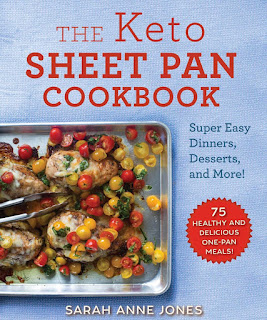 I
don't follow any particular diet, although we are big believers in
home-cooked meals and eat plenty of vegetarian dinners. We do, however,
have friends and family who follow a vegan, gluten free, or keto diet.
When I saw Sarah Anne Jones's The Keto Sheet Pan Cookbook: Super Easy Dinners, Desserts, and More
(Skyhorse, Oct. 1), I thought it would make a good addition to my
collection. Before reading this cookbook, I didn't know much about the
keto diet, beyond the fact that it avoided carbs. I was concerned that
it was all meat, all the time, but really it's more diverse than that. The Keto Sheet Pan Cookbook
includes meal planning tips, nutritional information, buying guides,
and ingredient guides. Now to the recipes. I haven't yet cooked from
this book, but I like the looks of the oven-baked fritattas (how perfect
for a Sunday morning when you have guests), the Jamaican Jerk Chick
with Turnips (we like spicy), Pesto Chicken Tenders with Green Beans
(looks like a good weeknight dinner), Kielbasa and Cabbage (another
simple dinner), Beef and Broccoli (without the rice), Chipotle-Lime
Shrimp (yum!), and more. The desserts interest me less because I'm not a
fan of the sugar substitutes, but if you're following a keto diet,
you'll probably be happy to have recipes for Texas Sheet Cake, No-Bake
Peanut Butter Bars, and Lemon Bars. I'm not going to argue the benefits
(or not) of the diet, and my initial interest was purely to find a way
to safely feed my keto friends. But I'm really happy to have discovered
another source of sheet pan recipes that we'll use often. There's no
keto police, I can go ahead and add rice or quinoa if I want.
I
don't follow any particular diet, although we are big believers in
home-cooked meals and eat plenty of vegetarian dinners. We do, however,
have friends and family who follow a vegan, gluten free, or keto diet.
When I saw Sarah Anne Jones's The Keto Sheet Pan Cookbook: Super Easy Dinners, Desserts, and More
(Skyhorse, Oct. 1), I thought it would make a good addition to my
collection. Before reading this cookbook, I didn't know much about the
keto diet, beyond the fact that it avoided carbs. I was concerned that
it was all meat, all the time, but really it's more diverse than that. The Keto Sheet Pan Cookbook
includes meal planning tips, nutritional information, buying guides,
and ingredient guides. Now to the recipes. I haven't yet cooked from
this book, but I like the looks of the oven-baked fritattas (how perfect
for a Sunday morning when you have guests), the Jamaican Jerk Chick
with Turnips (we like spicy), Pesto Chicken Tenders with Green Beans
(looks like a good weeknight dinner), Kielbasa and Cabbage (another
simple dinner), Beef and Broccoli (without the rice), Chipotle-Lime
Shrimp (yum!), and more. The desserts interest me less because I'm not a
fan of the sugar substitutes, but if you're following a keto diet,
you'll probably be happy to have recipes for Texas Sheet Cake, No-Bake
Peanut Butter Bars, and Lemon Bars. I'm not going to argue the benefits
(or not) of the diet, and my initial interest was purely to find a way
to safely feed my keto friends. But I'm really happy to have discovered
another source of sheet pan recipes that we'll use often. There's no
keto police, I can go ahead and add rice or quinoa if I want.

 As you know, I love my cast iron. I own maybe eight skillets and use at least one of them pretty much every day. Cast-Iron Cooking for Two: 75 Quick and Easy Skillet Recipes by Joanna Pruess with photos by Noah Fecks
(Skyhorse, Oct. 1) seemed like the cookbook for me. Pruess jumps right
into the recipes, which are divided into familiar chapters from
breakfast to dessert. Cast-Iron Cooking for Two offers a variety
of dishes to get through your average workweek (Grilled Cheese with
Bacon and Beer-Braised Onions) to the little more unusual (Sweet Potato
Pancakes with Asian Brussels Sprouts Slaw). Mains range from savory
vegetarian bread pudding to game hens and lamb shanks and lots of
everyday dinners in between. The desserts are fruit forward (crisps,
clafoutis), although there's a skillet brownie recipe too. I love that
the meals are on a small scale. Although I have no problem eating
leftovers, it's nice to cook something that we can eat in one night. If
you have four people to feed, I don't think you'd have any problem
doubling up on most recipes, especially the breakfasts, sides, and
mains. The cookbook ends with tips on cooking with cast-iron, how to
clean and care for your pans, and information on buying skillets if you
don't already own one. Like I said, I'm a big fan of cast-iron and will
be cooking out of this book often. I especially have my eye on the After
Thanksgiving Breakfast Hash . . . what a great way to eat up some of
the holiday bounty.
As you know, I love my cast iron. I own maybe eight skillets and use at least one of them pretty much every day. Cast-Iron Cooking for Two: 75 Quick and Easy Skillet Recipes by Joanna Pruess with photos by Noah Fecks
(Skyhorse, Oct. 1) seemed like the cookbook for me. Pruess jumps right
into the recipes, which are divided into familiar chapters from
breakfast to dessert. Cast-Iron Cooking for Two offers a variety
of dishes to get through your average workweek (Grilled Cheese with
Bacon and Beer-Braised Onions) to the little more unusual (Sweet Potato
Pancakes with Asian Brussels Sprouts Slaw). Mains range from savory
vegetarian bread pudding to game hens and lamb shanks and lots of
everyday dinners in between. The desserts are fruit forward (crisps,
clafoutis), although there's a skillet brownie recipe too. I love that
the meals are on a small scale. Although I have no problem eating
leftovers, it's nice to cook something that we can eat in one night. If
you have four people to feed, I don't think you'd have any problem
doubling up on most recipes, especially the breakfasts, sides, and
mains. The cookbook ends with tips on cooking with cast-iron, how to
clean and care for your pans, and information on buying skillets if you
don't already own one. Like I said, I'm a big fan of cast-iron and will
be cooking out of this book often. I especially have my eye on the After
Thanksgiving Breakfast Hash . . . what a great way to eat up some of
the holiday bounty.
19 October 2019
Weekend Cooking: The Saltwater Table by Whitney Otawka
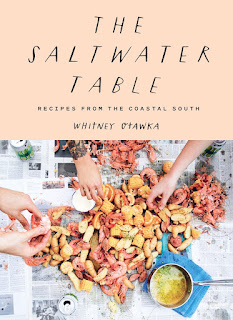 Happy Saturday. I hope your weekend is starting off well. As I write this post, I'm in a hotel room about 600 miles from my home kitchen and 20 miles from my temporary kitchen.
Happy Saturday. I hope your weekend is starting off well. As I write this post, I'm in a hotel room about 600 miles from my home kitchen and 20 miles from my temporary kitchen.
I had the opportunity to travel with my husband to Maine, where he's working for a week or so. Our trip, however, has been disrupted by Mother Nature. A mega wind storm this week took out our electricity, so we're holed up in a hotel, awaiting news on the power and tree removal crews.
Anyway, besides the power issue, I've been challenged with cooking in a strange kitchen. Vacation houses are equipped with the bare minimum tools and, of course, a bare pantry. Nonetheless, I managed to make some pretty awesome dinners, even if I couldn't find a cheese grater.
I had several recipes marked to try from Whitney Otawka's The Saltwater Table (Abrams, Oct. 22), which I received as part of the Abrams Dinner Party. The two I made were delicious, even though I had to adjust to the equipment on hand.
First let me tell you a little bit about this cookbook. By the title and subtitle (Recipes from the Coastal South), I was expecting a seafood cookbook. Yes, there are plenty of oyster and shrimp dishes, but The Saltwater Table is also full of side dishes, meat mains, vegetable recipes, and desserts, all with an eye to sharing with friends and family.
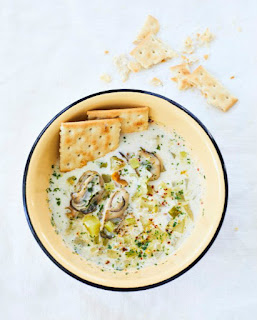 Otawka offers menu and party ideas (a spring vegetable feast, a Low Country boil), and plenty of great tips: working with herbs and flowers, how to build an outdoor cooking fire, and what to do with hot peppers, for example. The beautiful matte paper and full-page photos draw you in, and Otawka's personal stories give you context.
Otawka offers menu and party ideas (a spring vegetable feast, a Low Country boil), and plenty of great tips: working with herbs and flowers, how to build an outdoor cooking fire, and what to do with hot peppers, for example. The beautiful matte paper and full-page photos draw you in, and Otawka's personal stories give you context.
Some of the recipes I want to make are Pan-Roasted Flounder, Grapefruit Tart, Heirloom Tomato Bloody Mary, Shrimp Rolls, Lamb Meatballs, Seafood Chowder (see the scan), and Asparagus and Green Hill Frittata.
The first recipe I tried was Winter Root Vegetable Soup with Ham Hock and Turnip Green Pistou. My soup ended up being "inspired by" the original because I couldn't find a ham hock in the grocery store up here and the house doesn't have a blender or food processor. I cooked ham plus the leeks, turnips, carrots, rutabaga, and garlic in boxed chicken broth, seasoned it up as directed, and topped it with jarred basil pesto. No matter that I didn't quite pull off the original, the soup was delicious and I can't wait to make it Otawka's way.
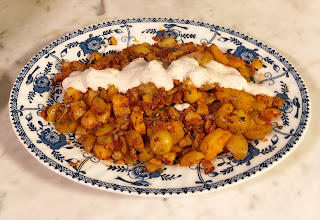 The other recipe I made from The Saltwater Table was also fabulous. Crispy Smashed Potatoes with Horseradish and Sea Salt. OMG, this is our new favorite way to make potatoes. I had to do a little adapting here (no cast-iron skillet, so I did that step in the oven and then broiler), but the results didn't suffer. I served these with simple pan-seared chicken breasts and broccoli (see my photo).
The other recipe I made from The Saltwater Table was also fabulous. Crispy Smashed Potatoes with Horseradish and Sea Salt. OMG, this is our new favorite way to make potatoes. I had to do a little adapting here (no cast-iron skillet, so I did that step in the oven and then broiler), but the results didn't suffer. I served these with simple pan-seared chicken breasts and broccoli (see my photo).
One of the most important things I learned about Whitney Otawka's The Saltwater Table is how adaptable her recipes are. I didn't need a fancy kitchen or special pots and pans to make delicious dishes using the recipes in this book. I think many of us can appreciate that. I also love the variety of recipes Otawka included; you don't have to live on the coast to use this cookbook. Even land-locked me found plenty of recipes to dream about making -- once the lights come back on.
 Weekend Cooking is open to anyone who has any kind of food-related post to share: Book reviews (novel, nonfiction), cookbook reviews, movie reviews, recipes, random thoughts, gadgets, quotations, photographs, restaurant reviews, travel information, or fun food facts. If your post is even vaguely foodie, feel free to grab the button and link up anytime over the weekend. You do not have to post on the weekend. Please link to your specific post, not your blog's home page.
Weekend Cooking is open to anyone who has any kind of food-related post to share: Book reviews (novel, nonfiction), cookbook reviews, movie reviews, recipes, random thoughts, gadgets, quotations, photographs, restaurant reviews, travel information, or fun food facts. If your post is even vaguely foodie, feel free to grab the button and link up anytime over the weekend. You do not have to post on the weekend. Please link to your specific post, not your blog's home page.NOTE: Mr. Linky sometimes is mean and will give you an error message. He's usually wrong and your link went through just fine the first time. Grrrr.
_______
Click for more
16 October 2019
15 October 2019
Today's Read: The Art of Regret by Mary Fleming
 Imagine
that you have accepted your unexceptional life as a solitary struggling
shop owner who lives above his store. How would you react when chance
circumstances boost your business? What if you then begin a forbidden
love affair? At some point you will have to face the consequences of
these life changes. Here is how Trevor McFarquhar's story begins:
Imagine
that you have accepted your unexceptional life as a solitary struggling
shop owner who lives above his store. How would you react when chance
circumstances boost your business? What if you then begin a forbidden
love affair? At some point you will have to face the consequences of
these life changes. Here is how Trevor McFarquhar's story begins:
For many years, in what might have been the prime of my life, I lived and worked on the rue des Martyrs. This narrow market street, which begins its climb at the northern edge of the banking and insurance district and ends in the skein of streets that wraps around the Sacre Coeur at the heart of Montmartre, is not on the tourist circuit and has no pretensions to Parisian grandeur. Behind and above its modest shop fronts are forgettable lives. Lives like my own, which I had reduced to a box, a one-room apartment on top of a one-room shop. Though the two were once a unit, at some point and for some reason--to make more space, to rent the shop and studio separately--the connecting stairs had been disconnected and my room could only be reached by an enclosed stairway in the courtyard. It's not unusual in a city with a long history. Buildings change their function and configuration, and one structure is squeezed in front of, behind, or beside another. It's just such quirks that have made Paris Paris, a city of endless layers and perspectives, a city of story upon story.—The Art of Regret by Mary Fleming (She Writes Press, Oct. 22, p. 10 [ARC])
Quick Facts
- Setting: Paris, mid-1990s
- Circumstances: Trevor McFarquhar was born in America but grew up in Paris after his newly widowed mother moved with her two young sons to France. Now in his late thirties, Trevor is estranged from his family and lives above his bicycle shop, barely squeaking by. His life changes when a transit strike creates a demand for bikes and a long-smouldering romance is given a chance to bloom. The newfound business success comes at the nick of time, but his relationship could cut the last remaining threads Trevor has with his mother and brother. Trevor is forced to set priorities and decide what kind of man he wants to be.
- Genre & themes: fiction; second chances, late coming-of-age, healing old wounds, family, family secrets
- Some random thoughts: Trevor is dealing with many unresolved issues from his past and has conflicted feelings about his family. Thus he finds it difficult to make connections and has been happy with casual hook-ups and uncommitted relationships. His business success has given him a new outlook, but he remains irresponsible when it comes to romantic partners. I'm curious if he has the courage to confront his past and change his present.
- The author: Fleming, herself an American who has relocated to France, fills her novel with insider details of Paris, including prevailing attitudes about families, social class, and politics.
- Acknowledgments: Thanks to Caitlin Hamilton Marketing & Publicity for the review copy of The Art of Regret.
14 October 2019
Stacked-Up Book Thoughts: What I Read Last Week
 Last
week was interesting to say the least. It started out with a mini-work
crunch brought on because I decided to accompany my husband to Maine. He
is here for work, and because I work for myself and from home, I was
able to temporarily relocate my office. But first I had to work ahead,
then we had to get the house ready for the house sitter, and then we had
the long drive up to New England.
Last
week was interesting to say the least. It started out with a mini-work
crunch brought on because I decided to accompany my husband to Maine. He
is here for work, and because I work for myself and from home, I was
able to temporarily relocate my office. But first I had to work ahead,
then we had to get the house ready for the house sitter, and then we had
the long drive up to New England.
Despite the hassles, I’m glad I made the trip.
I
didn’t have much time to read or listen last week, but I did manage to
finish two short books, ditch another one, and start a couple more.
 Machine by Susan Steinberg
(Graywolf, Aug. 20). A short novel that can be interpreted in a number
of ways. In this book, all of the characters and locations remain
nameless, but the story takes place over the course of a summer at the
shore (which says New Jersey to me) and is told through the eyes of a
privileged teenage girl. This the summer the teenager’s perspective
shifts, particularly after one of the local girls drowns during a night
of partying. Besides obsessing over the circumstances of the death (was
her brother involved? was it an accident? did she herself play a part?),
she is awakened to her parents’ flaws, her brother’s downhill spiral,
and her own place in the world. She begins to sense both the power and
limitations of being female, and begins to make deeper connections
between wealth, choices, actions, and consequences. That’s a lot to fit
into 144 pages, but Steinberg pulls it off. There’s a poetic rhythm to
the text, especially as the protagonist’s thoughts spill out and the
girl is filled with a jumble of emotions. Machine isn’t for
everyone, but it could make my top ten list for this year. Sophie Amoss
does an amazing job performing the unabridged audiobook (Blackstone; 3
hr, 34 min); see AudioFile magazine for my audiobook review. (audiobook
provided for freelance assignment)
Machine by Susan Steinberg
(Graywolf, Aug. 20). A short novel that can be interpreted in a number
of ways. In this book, all of the characters and locations remain
nameless, but the story takes place over the course of a summer at the
shore (which says New Jersey to me) and is told through the eyes of a
privileged teenage girl. This the summer the teenager’s perspective
shifts, particularly after one of the local girls drowns during a night
of partying. Besides obsessing over the circumstances of the death (was
her brother involved? was it an accident? did she herself play a part?),
she is awakened to her parents’ flaws, her brother’s downhill spiral,
and her own place in the world. She begins to sense both the power and
limitations of being female, and begins to make deeper connections
between wealth, choices, actions, and consequences. That’s a lot to fit
into 144 pages, but Steinberg pulls it off. There’s a poetic rhythm to
the text, especially as the protagonist’s thoughts spill out and the
girl is filled with a jumble of emotions. Machine isn’t for
everyone, but it could make my top ten list for this year. Sophie Amoss
does an amazing job performing the unabridged audiobook (Blackstone; 3
hr, 34 min); see AudioFile magazine for my audiobook review. (audiobook
provided for freelance assignment)
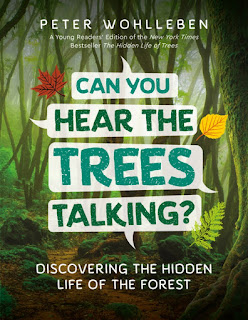 Can You Hear the Trees Talking? by Peter Wohlleben (Greystone Kids, Oct. 1). Both Mr. BFR and I loved Wohleben’s The Secret Live of Trees,
and I was curious how the German forester would transform that essay
collection into a book for middle grade readers. What I found was a
delightful way to introduce children to the wonders of the trees and to
the world of the forest. Wohlleben begins each chapter with a question,
such as Do trees get thirsty? How do trees have children? Can trees talk
to each other? and What makes trees sick? The answers are fun and easy
to read and are illustrated with great photos, including pictures of
children and animals in the great outdoors. Readers will find quizzes,
experiments to try, and observational quests. We learn about the
animals, fungi, and bugs that interact with trees, and we discover the
benefits of trees in the wild and in the city. The book ends with a look
at a forest through the seasons. Any child who is curious about nature
would love Can You Hear the Trees Talking?, and it would make a
great book for family activities as well as for use in a traditional or
homeschool curriculum. For more about Wohleben, see Greystone Book’s interview. (digital copy provided by the publisher)
Can You Hear the Trees Talking? by Peter Wohlleben (Greystone Kids, Oct. 1). Both Mr. BFR and I loved Wohleben’s The Secret Live of Trees,
and I was curious how the German forester would transform that essay
collection into a book for middle grade readers. What I found was a
delightful way to introduce children to the wonders of the trees and to
the world of the forest. Wohlleben begins each chapter with a question,
such as Do trees get thirsty? How do trees have children? Can trees talk
to each other? and What makes trees sick? The answers are fun and easy
to read and are illustrated with great photos, including pictures of
children and animals in the great outdoors. Readers will find quizzes,
experiments to try, and observational quests. We learn about the
animals, fungi, and bugs that interact with trees, and we discover the
benefits of trees in the wild and in the city. The book ends with a look
at a forest through the seasons. Any child who is curious about nature
would love Can You Hear the Trees Talking?, and it would make a
great book for family activities as well as for use in a traditional or
homeschool curriculum. For more about Wohleben, see Greystone Book’s interview. (digital copy provided by the publisher)
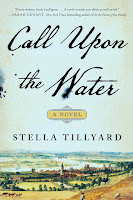 Call Upon the Water by Stella Tillyard
(Atria, Sept. 17). The story of a seventeenth-century Dutch engineer
and surveyor who helped with “draining and developing an expanse of
marshy wetlands known as the Great Level” in England. After a
complicated relationship with a woman he met in the marshes, Jan flees
to the New World, where his services are again needed in New Amsterdam. I
really wanted to love this book, but despite great period details and
the promise of intrigue, betrayal, and maybe romance, I just didn’t
connect to Jan or his situation. I tried this book in print, digital,
and audio formats, but in the end, I decided to put it aside at just
about halfway through. Note that other reviewers have raved about Call Upon the Water,
and perhaps I should have read or listened to it during a calmer week.
If you like historical fiction that offers a mix of science and drama,
you should give it a try. (all three formats provided by the publisher)
Call Upon the Water by Stella Tillyard
(Atria, Sept. 17). The story of a seventeenth-century Dutch engineer
and surveyor who helped with “draining and developing an expanse of
marshy wetlands known as the Great Level” in England. After a
complicated relationship with a woman he met in the marshes, Jan flees
to the New World, where his services are again needed in New Amsterdam. I
really wanted to love this book, but despite great period details and
the promise of intrigue, betrayal, and maybe romance, I just didn’t
connect to Jan or his situation. I tried this book in print, digital,
and audio formats, but in the end, I decided to put it aside at just
about halfway through. Note that other reviewers have raved about Call Upon the Water,
and perhaps I should have read or listened to it during a calmer week.
If you like historical fiction that offers a mix of science and drama,
you should give it a try. (all three formats provided by the publisher)
12 October 2019
Weekend Cooking: From Scratch by Michael Ruhlman
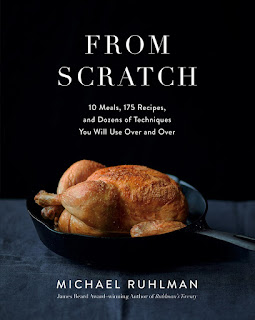 You'll have to forgive me if I start this post by quoting myself, when I wrote about Michael Ruhlman's book How to Roast, because I can't introduce him any better than I did then:
You'll have to forgive me if I start this post by quoting myself, when I wrote about Michael Ruhlman's book How to Roast, because I can't introduce him any better than I did then:
There are a handful of cookbook authors whose books I just have to own: sometimes because I know the recipes will be foolproof and sometimes because I know I'll learn something. Michael Ruhlman succeeds on both these accounts while providing that magic third element of timelessness.Michael Ruhlman's newest book is From Scratch (Abrams, Oct. 15), which I received as part of the Abrams Dinner Party program. I was happy to see that Ruhlman included my all-time favorite way to roast chicken (see the cover photo), which I discovered in his earlier roasting book. You may think you know how to roast chicken, but his method is seriously moist and delicious.
Now, here's where From Scratch does something a bit different. Ruhlman doesn't stop with the main dish, he goes on to teach us how to make a couple of sauces, how to brine a chicken (if we're so inclined), and how to add in a salsa verde or other flavors. He tells us how to cook a spatchcocked chicken (another favorite of mine) and how to turn a store-bought rotisserie chicken into a comforting feast after a long day.
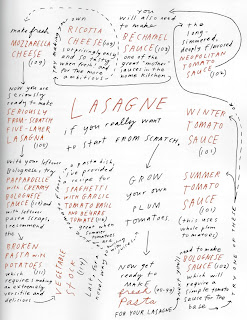 But wait, there's more! What else can you do with your chicken? Ruhlman to the recuse: make stock, make soup, make consomme. Serve it with Brussel sprouts or broccoli and take your pick of potato options. Have leftovers? Make a chicken salad or chicken pot pie.
But wait, there's more! What else can you do with your chicken? Ruhlman to the recuse: make stock, make soup, make consomme. Serve it with Brussel sprouts or broccoli and take your pick of potato options. Have leftovers? Make a chicken salad or chicken pot pie.Ruhlman treats omelets, lasagna, steak frites, paella, cassoulet, slow-roasted pork shoulder, curry, the BLT, and the profiterole in the same manner. A base recipe spins and curves and bends into many others (see the scan to the right). So you see, even though the subtitle says "10 meals," the 175 included recipes help you create enough dinners to get you through, say, a half year. Then you can start all over again and continue to perfect your skills.
Ruhlman adds plenty of extras throughout From Scratch, such as notes on specific ingredients (like summer tomatoes), thoughts on a variety of dishes (like risotto), and tips on techniques (like toasting spices). You'll also find a few cocktail recipes and lots of solid good advice.
I love Ruhlman's easygoing attitude about what "from scratch" means. While it'd be amazing to raise your own livestock and grow your own grains, vegetables, and fruit to make a truly from scratch dinner, in the long run:
"From Scratch" is an attitude, not a recipe or a ridgid set of instructions. Take a whole chicken, place it in a skillet, roast it in a hot oven for an hour--dinner from scratch.Michael Ruhlman's From Scratch is the perfect cookbook for anyone who wants to hone his or her kitchen skills, whether that person is just learning to cook or has been cooking for decades. Besides all the delicious, well-presented recipes, I love how Ruhlman demonstrates just how easy it is to serve from-scratch dinners, even after a jam-packed day at work or school. If you've been in a rut or have lost your cooking mojo or passion, this is the book for you. If you love to cook or wish you knew how to cook or if you're somewhere in between, put From Scratch on your wish list.
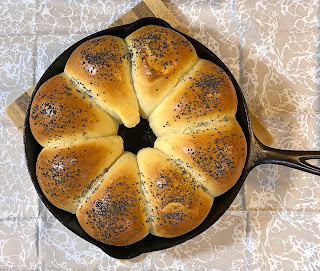 The first from scratch dinner I made From Scratch was pulled pork sandwiches. I made the bread from scratch, I cooked the pork (locally produced) slow and low in the oven, I made the BBQ sauce, and I made the broccoli slaw using vegetables from the farmer's market. I did buy the pickles, but, hey, I didn't have weeks to wait!
The first from scratch dinner I made From Scratch was pulled pork sandwiches. I made the bread from scratch, I cooked the pork (locally produced) slow and low in the oven, I made the BBQ sauce, and I made the broccoli slaw using vegetables from the farmer's market. I did buy the pickles, but, hey, I didn't have weeks to wait!Ruhlman's Slow-Roasted Pork Shoulder was amazingly tender and flavorful for such a simple preparation. The recipe includes quite a lot of extra information and tips on how to speed up the process or slow it down, so I encourage you to get a copy of the cookbook (from the library or the store).
The photos (above and below) are of my own bread baked from Ruhlman's recipe (it looks just like the photo in the book!) and the finished dish. We were in heaven.
Slow-Roasted Pork Shoulder
 Serves 8
Serves 8- 1 (4-pound / 1.8 kilogram) bone-in pork shoulder or 1 (3-pound / 1.36 kilogram boneless pork shoulder
- Kosher salt and freshly ground black pepper to taste
Give all surfaces of the pork a generous coating of salt. Put the pork in a Dutch oven or other large pot, cover it, and put it in the oven for 4 hours (or a little less for a boneless shoulder).
Remove the lid and check to see if it's tender by shredding it with two forks. If it doesn't pull easily, cover the pot and return it to the oven for another hour, or until it does.
 Weekend Cooking is open to anyone who has any kind of food-related post to share: Book reviews (novel, nonfiction), cookbook reviews, movie reviews, recipes, random thoughts, gadgets, quotations, photographs, restaurant reviews, travel information, or fun food facts. If your post is even vaguely foodie, feel free to grab the button and link up anytime over the weekend. You do not have to post on the weekend. Please link to your specific post, not your blog's home page.
Weekend Cooking is open to anyone who has any kind of food-related post to share: Book reviews (novel, nonfiction), cookbook reviews, movie reviews, recipes, random thoughts, gadgets, quotations, photographs, restaurant reviews, travel information, or fun food facts. If your post is even vaguely foodie, feel free to grab the button and link up anytime over the weekend. You do not have to post on the weekend. Please link to your specific post, not your blog's home page.NOTE: Mr. Linky sometimes is mean and will give you an error message. He's usually wrong and your link went through just fine the first time. Grrrr.
_______
Click for more
11 October 2019
Still Reading; or What's in My (Virtual) Book Tote
Am I the only one who has more than one style of reading? I bet not.
Most of the time, I read books the regular way—starting on page 1 and
reading to the end, straight through, in short order. Other books I read
piecemeal over the course of several weeks or even months, and not
necessarily in order from the first page to the last.
What?
Am I crazy? Maybe, but let me explain. The books I’m talking about are
collections of short stories or essays, travel writing, food writing,
history, some biographies, and other nonfiction. For example, I might be
interested in a trade book on, say, dinosaurs. Because I’ve read quite a
lot about paleontology, not only in graduate school but also for fun,
my approach may be to skim some of the background chapters and then to
read carefully when the author turns to newer research or discoveries.
I’m
content with my weird reading habits, but I’m often uncomfortable
talking about the books I've read unconventionally here on Beth Fish
Reads. I can't help but wonder if I should share my thoughts about a
book I haven’t read cover to cover or that took me a while to read. It’s
silly isn’t it? If I make it clear I’m still reading, then why not let
you know what I think so far?
That’s what today’s post is all about. Here are the books in my current slow-read stack. (Print or digital copies provided by the publisher or publicist.)
 I’m
a huge Lord of the Rings fan, which I first read when I was in sixth or
seventh grade. Since then, I’ve reread the entire series, starting with
The Hobbit, about every five years. It’s no surprise that I was excited to get a chance to read David Day’s An Encyclopedia of Tolkien: The History and Mythology That Inspired Tolkien’s World
(Canterbury Classics, Oct. 8). Before I get to the contents, just let
me tell you that this leather-bound hardback is simply gorgeous. It has
gilded edges, a marker ribbon, and contains close to 200 beautiful
black-and-white drawings of Tolkien’s universe. Day includes entries on
people and characters, lands, creatures, and events found in the books.
Some entries relate to Tolkien’s inspirations and scholarship, and
others are about gods and legends from various traditions (Greek, Roman,
Norse, biblical). I’ve been flipping through, admiring the artwork and
reading the entries that catch my eye. If you are a LOTR fan, then you
must have a copy, and if there is a Tolkien lover in your family, then
this is the perfect gift.
I’m
a huge Lord of the Rings fan, which I first read when I was in sixth or
seventh grade. Since then, I’ve reread the entire series, starting with
The Hobbit, about every five years. It’s no surprise that I was excited to get a chance to read David Day’s An Encyclopedia of Tolkien: The History and Mythology That Inspired Tolkien’s World
(Canterbury Classics, Oct. 8). Before I get to the contents, just let
me tell you that this leather-bound hardback is simply gorgeous. It has
gilded edges, a marker ribbon, and contains close to 200 beautiful
black-and-white drawings of Tolkien’s universe. Day includes entries on
people and characters, lands, creatures, and events found in the books.
Some entries relate to Tolkien’s inspirations and scholarship, and
others are about gods and legends from various traditions (Greek, Roman,
Norse, biblical). I’ve been flipping through, admiring the artwork and
reading the entries that catch my eye. If you are a LOTR fan, then you
must have a copy, and if there is a Tolkien lover in your family, then
this is the perfect gift.
 I’m
not sure what triggered my interest in the Middle Ages, but I find it
hard to resist novels set during that period, and I also like reading
medieval history. Kelcey Wilson-Lee’s biography and history, Daughters of Chivalry: The Forgotten Children of King Edward Longshanks
(Pegasus, Oct. 1) is more than the story of Edward I’s five daughters.
Wilson-Lee presents a non-romanticized look at the complex lives of
medieval noblewomen. I’m still in the early chapters, so can’t comment
on the overall level of scholarship or conclusions, but I like the
different perspectives. Women and girls were, of course, used by men for
political or economic gain; that didn’t mean, however, they were
totally without independence, that they couldn’t be successfully
defiant, or that they couldn’t find ways to take full advantage of their
circumstances. Far from being demure damsels in distress waiting for
their knight in shining armor, women sometimes had the power to save
themselves. I’m assuming Edward’s daughters do just that. Other themes
are education, childbirth, and court life.
I’m
not sure what triggered my interest in the Middle Ages, but I find it
hard to resist novels set during that period, and I also like reading
medieval history. Kelcey Wilson-Lee’s biography and history, Daughters of Chivalry: The Forgotten Children of King Edward Longshanks
(Pegasus, Oct. 1) is more than the story of Edward I’s five daughters.
Wilson-Lee presents a non-romanticized look at the complex lives of
medieval noblewomen. I’m still in the early chapters, so can’t comment
on the overall level of scholarship or conclusions, but I like the
different perspectives. Women and girls were, of course, used by men for
political or economic gain; that didn’t mean, however, they were
totally without independence, that they couldn’t be successfully
defiant, or that they couldn’t find ways to take full advantage of their
circumstances. Far from being demure damsels in distress waiting for
their knight in shining armor, women sometimes had the power to save
themselves. I’m assuming Edward’s daughters do just that. Other themes
are education, childbirth, and court life.
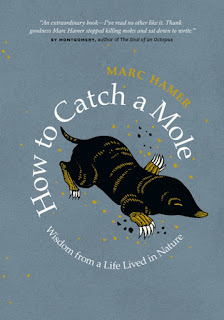 My father was on a lifelong mission to rid our yard and gardens of moles. This was one battle he lost. In How to Catch a Mole: Wisdom from a Life Lived in Nature (Greystone, Oct. 1), Marc Hamer
shares his journey from professional mole hunter to mole accepter. This
book offers a little bit of everything because Hamer, himself, has had a
multilayered life. The essays and poems collected here reveal the
hidden life of moles, recount Hamer's own journey to and from his
solitary profession, and bring us closer to nature. In the introduction,
Hamer tells us,
My father was on a lifelong mission to rid our yard and gardens of moles. This was one battle he lost. In How to Catch a Mole: Wisdom from a Life Lived in Nature (Greystone, Oct. 1), Marc Hamer
shares his journey from professional mole hunter to mole accepter. This
book offers a little bit of everything because Hamer, himself, has had a
multilayered life. The essays and poems collected here reveal the
hidden life of moles, recount Hamer's own journey to and from his
solitary profession, and bring us closer to nature. In the introduction,
Hamer tells us,
There is a difference between truth and honesty, so I am going to tell you one of the millions of honest stories that I could tell you that might be good enough to call ‘true’. One of the stories that led me to the point of kneeling in a muddy field in December with a dead mole in my hand and deciding it was time to stop killing.The book is beautifully illustrated with black-and-white drawings by Joe McLaren. I'm reading this collection, one essay or poem at a time. One thing, though, even if my dad (who really did love animals) had had the chance to read this book, I doubt he'd have given up on his dream of a mole-free property. Click for more
08 October 2019
6 New Cookbooks I Love

In fact, I have so many cookbooks to cover, I've run out of Saturday Weekend Cooking space. Still I really need
to share all the great new books with you. Thus I'm trying something
different this month. Here's the breakdown of what to expect.
- Twitter, Instagram, or Litsy (@BethFishReads): I have already posted some photos and stories of dishes I've made from October cookbooks. You'll see more throughout the month.
- Weekend Cooking: I'm devoting Saturdays to books from the Abrams Dinner Party.
- Today's Read: I have two Tuesdays devoted to individual cookbook or food writing reviews. Last Tuesday was Aaron Sanchez's new memoir, Where I Come From (from Abrams).
- Mini-Reviews: Finally, I plan to write two posts devoted to mini reviews and features (today is the first one).
Now that you have the October cookbook scoop, let's get to the first batch of reviews, presented in no particular order. (Note: print or digital copies of all of these were provided by the publisher)
 I
love collecting cookbooks with a literary theme and those celebrating
favorite novels or authors. It should come as no surprise that Wini Moranville's The Little Women Cookbook (Harvard Common Press, Oct. 1) caught my eye. With this celebration of the 150th anniversary of Little Women
in hand, you can re-create many of the foods and drinks mentioned in
the story. Moranville took a three-pronged approach. First she made note
of the many food references in the novel; then she looked a period
cookbooks and archives to find recipes. Finally, she made sure those
recipes were doable in modern times and tweaked them to 21st-century
tastes. Each recipe is introduced with a quote or a blurb to tie it to
Louisa May Alcott's book, and throughout the cookbook, you'll find other
information about the Alcotts and about food in the mid-1800s. Marked to try: maple-cornmeal drop biscuits, chicken salad with grapes and almonds, Hannah's cottage pie.
I
love collecting cookbooks with a literary theme and those celebrating
favorite novels or authors. It should come as no surprise that Wini Moranville's The Little Women Cookbook (Harvard Common Press, Oct. 1) caught my eye. With this celebration of the 150th anniversary of Little Women
in hand, you can re-create many of the foods and drinks mentioned in
the story. Moranville took a three-pronged approach. First she made note
of the many food references in the novel; then she looked a period
cookbooks and archives to find recipes. Finally, she made sure those
recipes were doable in modern times and tweaked them to 21st-century
tastes. Each recipe is introduced with a quote or a blurb to tie it to
Louisa May Alcott's book, and throughout the cookbook, you'll find other
information about the Alcotts and about food in the mid-1800s. Marked to try: maple-cornmeal drop biscuits, chicken salad with grapes and almonds, Hannah's cottage pie.One of the sad, sad things about my late-in-life peanut allergy is that I can't eat Asian food in restaurants. This is really hard because I love noodle-y food like pad Thai. Thank you Maki Watanabe, your new cookbook Asian Noodles (Tuttle, Oct. 29) is just what I needed. Now I can make my own noodle dishes from Vietnam, Thailand, China, Korea, and Japan at home. If a dish calls for peanuts, I can make a substitution. Here are a few things I really like about this cookbook: Each recipe is accompanied by a beautiful photo of the finished dish. I especially appreciate photos when I'm learning new techniques or working with new ingredients. Watanabe includes instructions for cooking the different kinds of Asian noodles to help make her recipes no-fail. I love the variety of dishes, including stir-fries, noodle bowls, soups, and desserts. Finally, you'll find tips and tricks and useful information scattered throughout the book. Recipe I tried: five-spice pork noodles (yum!) Marked to try: Taiwanese chicken noodles, chicken pho noodle soup, stir-fried mi fun with lots of vegetables.
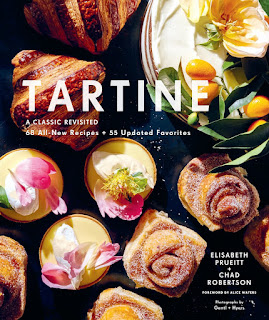 It's really hard to believe that I bought my first Tartine cookbook a dozen years ago. The new Tartine by Elizabeth M. Prueitt and Chad Robertson
(Chronicle, Oct. 1) is a pastry and dessert book for today's baker.
About half the book features updated versions of older recipes and the
other half consists of new delights. Yes, the original recipes work just
fine, but the new book includes gluten-free options, more whole grain
breads, less sugar, new methods, and new ingredients. The cookbook
contains gorgeous photos and recipes for everything from muffins to
scones, pies, cookies, and cakes. One feature I really love is the
"Kitchen Notes" sections that accompany many (all?) recipes. Here you'll
find all kinds of tips, from how to transfer the dough to the pan to
how to make substitutions and information on why a certain ingredient is
called for. These are the gold mine of the cookbook. Marked to try: black tea blondies with caramel swirl, pecan maple pie with kumquats and bourbon, almond-lemon tea cake.
It's really hard to believe that I bought my first Tartine cookbook a dozen years ago. The new Tartine by Elizabeth M. Prueitt and Chad Robertson
(Chronicle, Oct. 1) is a pastry and dessert book for today's baker.
About half the book features updated versions of older recipes and the
other half consists of new delights. Yes, the original recipes work just
fine, but the new book includes gluten-free options, more whole grain
breads, less sugar, new methods, and new ingredients. The cookbook
contains gorgeous photos and recipes for everything from muffins to
scones, pies, cookies, and cakes. One feature I really love is the
"Kitchen Notes" sections that accompany many (all?) recipes. Here you'll
find all kinds of tips, from how to transfer the dough to the pan to
how to make substitutions and information on why a certain ingredient is
called for. These are the gold mine of the cookbook. Marked to try: black tea blondies with caramel swirl, pecan maple pie with kumquats and bourbon, almond-lemon tea cake.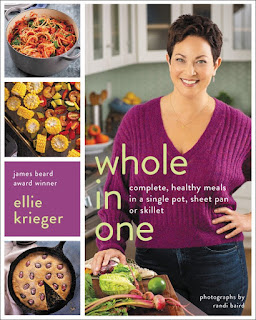 One of my go-to, totally reliable cookbook authors is Ellie Krieger and her new book, Whole in One
(Da Capo, Oct. 15) speaks to me on a lot of levels. Her dishes
are always healthful, and I love one-pot cooking (especially because I
don't have a dishwasher). The recipes in this book are broken down by
main ingredient: plant and dairy proteins; meats, fish, and fowl; and
desserts and, as I've come to expect from Krieger, the recipes are
straightforward, easy to follow, and use regular ole ingredients. The
dishes are also popping with flavor. Here's more good news: most of the
dishes can easily be make on a busy weeknight. I suspect this cookbook
will be well used in this house. Krieger starts with a discussion of needed equipment (yay for cast iron!), her thoughts
on good food and nutrition, and suggested pantry items. Then come the tempting
recipes. I didn't even bother to mark recipes, because, really, I could
make everything in the book. Recipes I tried: broccoli Cheddar
skillet strata (cast-iron skillet), herbed pork tenderloin with delicata
squash and Brussels sprouts (sheet pan).
One of my go-to, totally reliable cookbook authors is Ellie Krieger and her new book, Whole in One
(Da Capo, Oct. 15) speaks to me on a lot of levels. Her dishes
are always healthful, and I love one-pot cooking (especially because I
don't have a dishwasher). The recipes in this book are broken down by
main ingredient: plant and dairy proteins; meats, fish, and fowl; and
desserts and, as I've come to expect from Krieger, the recipes are
straightforward, easy to follow, and use regular ole ingredients. The
dishes are also popping with flavor. Here's more good news: most of the
dishes can easily be make on a busy weeknight. I suspect this cookbook
will be well used in this house. Krieger starts with a discussion of needed equipment (yay for cast iron!), her thoughts
on good food and nutrition, and suggested pantry items. Then come the tempting
recipes. I didn't even bother to mark recipes, because, really, I could
make everything in the book. Recipes I tried: broccoli Cheddar
skillet strata (cast-iron skillet), herbed pork tenderloin with delicata
squash and Brussels sprouts (sheet pan). Long, long ago, I drank the America's Test Kitchen Kool-Aid, and I've been a fan ever since. The newest book from America's Test Kitchen Kids is The Complete Baking Book for Young Chefs
(Sourcebooks Explore, Oct. 1). This book, like others in their Young
Chefs series, is colorful, informative, and sometimes funny. The photos
show a diverse group of kids baking up a storm, and each recipe includes
notes and reviews from young recipe testers. As you can expect from
ATK, the recipes may be suitable for youngsters but there is nothing
childish about the results. In fact, although I've been cooking and
baking for more years than I'm going to admit here, I learned a few
things from the beginning chapter on ingredients, techniques, and tips.
The kid testers' notes are really honest; for example, one girl said she
hated squeezing the liquid out of shredded zucchini, but because her
family loved the bread she baked, she decided it was worth it. Recipes
include scones, quick breads, muffins, and a variety of yeasted breads -- even pretzels. If yeast scares you, start with the recipes in this
book. Marked to try: cheese bread, pumpkin bread with chocolate chips, fluffy dinner rolls.
Long, long ago, I drank the America's Test Kitchen Kool-Aid, and I've been a fan ever since. The newest book from America's Test Kitchen Kids is The Complete Baking Book for Young Chefs
(Sourcebooks Explore, Oct. 1). This book, like others in their Young
Chefs series, is colorful, informative, and sometimes funny. The photos
show a diverse group of kids baking up a storm, and each recipe includes
notes and reviews from young recipe testers. As you can expect from
ATK, the recipes may be suitable for youngsters but there is nothing
childish about the results. In fact, although I've been cooking and
baking for more years than I'm going to admit here, I learned a few
things from the beginning chapter on ingredients, techniques, and tips.
The kid testers' notes are really honest; for example, one girl said she
hated squeezing the liquid out of shredded zucchini, but because her
family loved the bread she baked, she decided it was worth it. Recipes
include scones, quick breads, muffins, and a variety of yeasted breads -- even pretzels. If yeast scares you, start with the recipes in this
book. Marked to try: cheese bread, pumpkin bread with chocolate chips, fluffy dinner rolls. I try to stay out of the food world's drama, so I have nothing to say about Christopher Kimball's
departure from ATK or Cooks magazine. I still like his recipes and his
veiw point on food and cooking (though I don't know much about Milk
Street). His new cookbook is titled The New Rules (Voracious,
Oct. 15), and its subtitle promises that the recipes "will change the
way you cook." I haven't had much time to really delve into this one
yet, but each of the 75 chapters takes you through a particular flavor,
ingredient, technique, or dish. For example, you'll learn why a sheet
pan is better than a traditional roasting pan, how to get the best
flavor from garlic, how to use nuts with pasta dishes, and tricks for
braising. Kimball presents each rule and then offers a couple of recipes
that put that rule into action. There are also informative features,
such as one about oils and their smoking points and a super one on spice
blends. The recipes are appealing (Roman Braised Beef with Tomato and
Cloves) but are omnivore heavy, so vegetarians and vegans might want to
look before buying. I haven't marked any recipes in particular, but I'm
interested in trying out several of the "new rules."
Click for more
I try to stay out of the food world's drama, so I have nothing to say about Christopher Kimball's
departure from ATK or Cooks magazine. I still like his recipes and his
veiw point on food and cooking (though I don't know much about Milk
Street). His new cookbook is titled The New Rules (Voracious,
Oct. 15), and its subtitle promises that the recipes "will change the
way you cook." I haven't had much time to really delve into this one
yet, but each of the 75 chapters takes you through a particular flavor,
ingredient, technique, or dish. For example, you'll learn why a sheet
pan is better than a traditional roasting pan, how to get the best
flavor from garlic, how to use nuts with pasta dishes, and tricks for
braising. Kimball presents each rule and then offers a couple of recipes
that put that rule into action. There are also informative features,
such as one about oils and their smoking points and a super one on spice
blends. The recipes are appealing (Roman Braised Beef with Tomato and
Cloves) but are omnivore heavy, so vegetarians and vegans might want to
look before buying. I haven't marked any recipes in particular, but I'm
interested in trying out several of the "new rules."
Click for more
07 October 2019
Stacked-Up Book Thoughts: A Quiet Reading Week
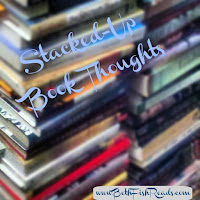 I
know this is a book blog, but the best parts of last week had nothing
to do with reading, even though they have a link to books.
I
know this is a book blog, but the best parts of last week had nothing
to do with reading, even though they have a link to books.
The first is bittersweet: I'm so happy that The Durrells in Corfu and Poldark
have returned to PBS, but I'm sad because this is the last season for
both. I love these series, each based on a book. If you're a Durrell
fan, here are two resources you might be interested in. The first is a Masterpiece theater podcast with the series screenwriter, Simon Nye, and the second is a one-hour documentary titled What the Durrells Did Next, which will premiere November 10 (check your local listing for air times).
Here's what I read last week:
 Careful What You Wish For by Hallie Ephron
(William Morrow, Aug. 6). Professional organizer Emily tries to ignore
her hoarder husband's addiction to garage sales by avoiding trips to the
basement, which is stuffed full of what she considers junk.
Nonetheless, she and her partner, Becca, run a successful business
helping others Maria Kondo their possessions. Everything is running
smoothly until they get a call from a desperate new client who begs for
help now! Becca has other plans, so Emily reluctantly agrees to
meet the woman alone. A needy client, a minor business mistake, and a
stressed marriage have Emily on edge, but when it looks like someone is
setting her up to take the fall for a murder, annoyance turns into fear.
This is a light thriller with agreeable characters, including Emily's
book-loving mother. The unabridged audiobook (HarperAudio; 7 hr, 46 min)
is read by Amy McFadden, who does a fine job highlighting Emily's
changing circumstances, from harried business owner to possible victim.
Full audiobook thoughts will be published by AudioFile Magazine. (auido
review copy for a freelance assignment)
Careful What You Wish For by Hallie Ephron
(William Morrow, Aug. 6). Professional organizer Emily tries to ignore
her hoarder husband's addiction to garage sales by avoiding trips to the
basement, which is stuffed full of what she considers junk.
Nonetheless, she and her partner, Becca, run a successful business
helping others Maria Kondo their possessions. Everything is running
smoothly until they get a call from a desperate new client who begs for
help now! Becca has other plans, so Emily reluctantly agrees to
meet the woman alone. A needy client, a minor business mistake, and a
stressed marriage have Emily on edge, but when it looks like someone is
setting her up to take the fall for a murder, annoyance turns into fear.
This is a light thriller with agreeable characters, including Emily's
book-loving mother. The unabridged audiobook (HarperAudio; 7 hr, 46 min)
is read by Amy McFadden, who does a fine job highlighting Emily's
changing circumstances, from harried business owner to possible victim.
Full audiobook thoughts will be published by AudioFile Magazine. (auido
review copy for a freelance assignment)
 Charlotte's Web by E. B. White with an introduction by Melissa Sweet
(Listening Library; 4 hr, 2 min). It's been decades since I last read
Charlotte's Web -- I think I was still in grade school -- but I couldn't
resist listening to this full-cast production of the beloved children's
book starring Meryl Streep (narrator), January LeVoy (Charlotte), Kirby
Heybourne (Wilbur) and many other well-known audiobook performers. I
was so pleasantly surprised to find I still enjoyed the story and was
absolutely delighted with the overall production: the personalities of
the geese, the rat, and even the baby spiders shone. Don't miss this
fabulous audiobook. You don't need to be a kid to root for Wilbur and
fall for Charlotte. (review copy provided by the publisher)
Charlotte's Web by E. B. White with an introduction by Melissa Sweet
(Listening Library; 4 hr, 2 min). It's been decades since I last read
Charlotte's Web -- I think I was still in grade school -- but I couldn't
resist listening to this full-cast production of the beloved children's
book starring Meryl Streep (narrator), January LeVoy (Charlotte), Kirby
Heybourne (Wilbur) and many other well-known audiobook performers. I
was so pleasantly surprised to find I still enjoyed the story and was
absolutely delighted with the overall production: the personalities of
the geese, the rat, and even the baby spiders shone. Don't miss this
fabulous audiobook. You don't need to be a kid to root for Wilbur and
fall for Charlotte. (review copy provided by the publisher)
 The Sisters of Summit Avenue by Lynn Cullen
(Gallery Books, Sept. 10). The story of mothers and daughters coming to
terms with family, mistakes, missed chances, and love, told in three
time periods. The novel follows three woman: Dorothy and her two
daughters, June and Ruth. Each has been damaged in some way and find it
difficult to express affection. Dorothy was abandoned by her family and
her lover when she becomes becomes pregnant near the turn of the last
century. In the early 1920s June and Ruth have a falling out, and June
ends up marrying into the upper class of Minneapolis while Ruth marries
June's old boyfriend and takes up life as a farm wife and mother. All
three women are unhappy but try to put their best face forward. Past
betrayals are awakened when June comes to visit Ruth in Indiana, and
before the day is out, everyone's lives have changed. The general themes
of the novel were appealing, but three points of view plus three time
periods were more disruptive than intriguing. The women were hard to
connect to, so I wasn't fully invested in their fates. The ending was a
little too neat to be satisfying. The best parts of the novel were the
early scenes in the General Mills Betty Crocker test kitchen, where June
works as one of the Bettys. If I gave ratings, this book would get
about a 3.2. (audio and digital copies provided by the publisher)
The Sisters of Summit Avenue by Lynn Cullen
(Gallery Books, Sept. 10). The story of mothers and daughters coming to
terms with family, mistakes, missed chances, and love, told in three
time periods. The novel follows three woman: Dorothy and her two
daughters, June and Ruth. Each has been damaged in some way and find it
difficult to express affection. Dorothy was abandoned by her family and
her lover when she becomes becomes pregnant near the turn of the last
century. In the early 1920s June and Ruth have a falling out, and June
ends up marrying into the upper class of Minneapolis while Ruth marries
June's old boyfriend and takes up life as a farm wife and mother. All
three women are unhappy but try to put their best face forward. Past
betrayals are awakened when June comes to visit Ruth in Indiana, and
before the day is out, everyone's lives have changed. The general themes
of the novel were appealing, but three points of view plus three time
periods were more disruptive than intriguing. The women were hard to
connect to, so I wasn't fully invested in their fates. The ending was a
little too neat to be satisfying. The best parts of the novel were the
early scenes in the General Mills Betty Crocker test kitchen, where June
works as one of the Bettys. If I gave ratings, this book would get
about a 3.2. (audio and digital copies provided by the publisher)



